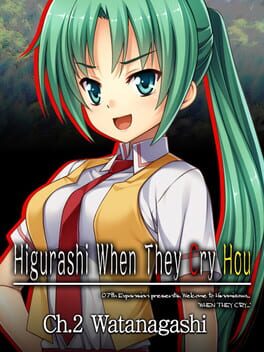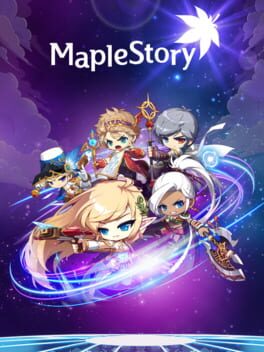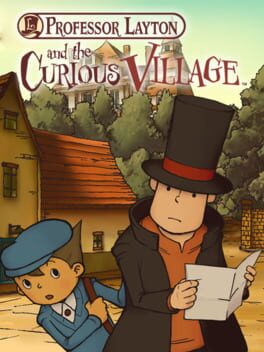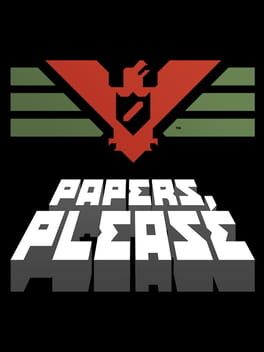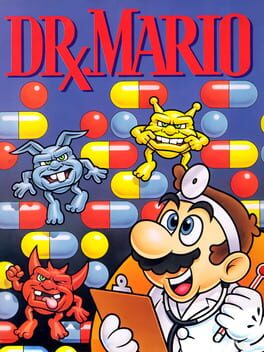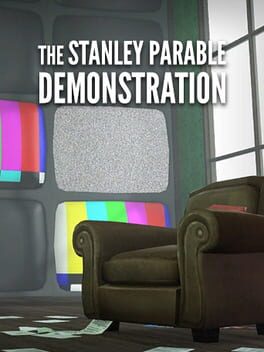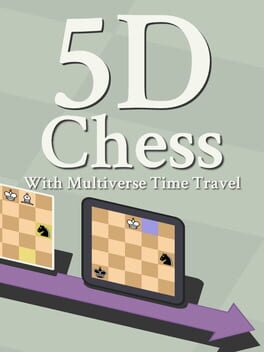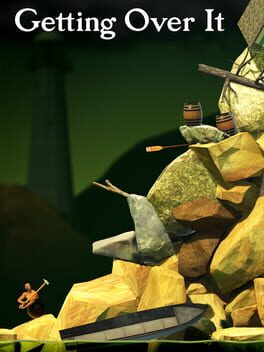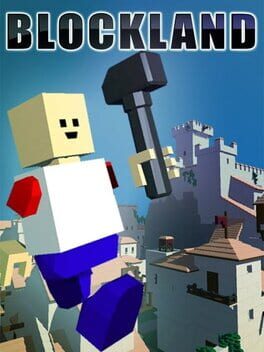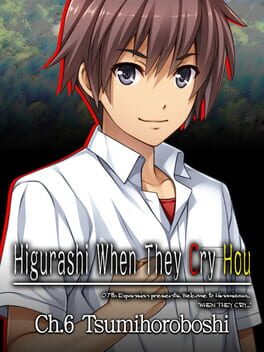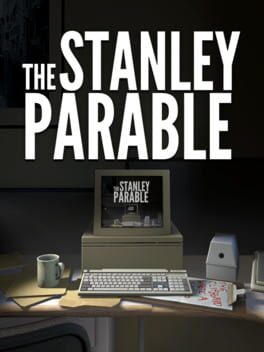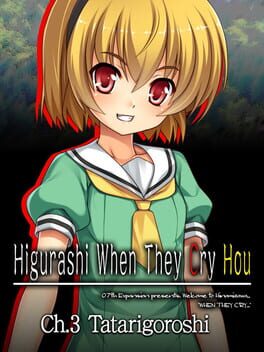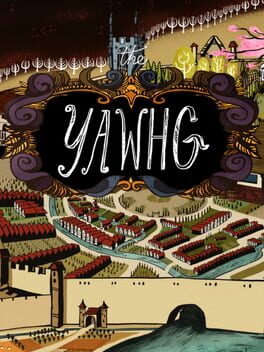ktoq
This review contains spoilers
Right after the chilling conclusion of Onikakushi - a visual novel which I loved going through - the complete reset of Watanagashi was utterly jarring. Resetting the time back to Keiichi's first forays into Hinamizawa completely baffled me at first. I started going through the more slice-of-life sections - club activities, walks home with Rena, the works. Everything seemed just as it was, until the introduction of the mysterious twin sister, Shion Sonozaki.
I love the way Shion is played for the first few chapters after her introduction. Both Keiichi and the player take her as some scheme made up by Mion to express herself as a woman to a greater extent. This is supplemented by past interactions with both Rena and Mion; even referring to herself as "[this] old man" on various occasions. Her femininity seems caged up if existent at all and even when Shion is revealed to be a seperate person from Mion later on, the seed of Mion's crisis have already been planted in your head and are not easily torn out for the remainder of the game.
This is perhaps the first thing that jumps out at me about Watanagashi, the cause-and-effect of the plot is felt far more strongly here than Onikakushi. Both are high-quality, slow-burning horror experiences that slowly inundate you in their world, but Watanagashi feels less like a sequence of events than the climax of hundreds of years of slowly boiling societal conflict, all concentrated onto the shoulders of one school-age girl. Even the most despicable villains in the game manage to make you feel for them - though Oyashiro's curse is definitely a plausible explanation which manages to fill in some narrative gaps, much more emphasis is placed in the scarier sections on how characters interact and intersect, whereas this was more largely relegated to the slice-of-life segments in Onikakushi. I like how the lines are drawn differently as well; in Onikakushi it's Keiichi against the world for the most part - as everyone who can leave him does until he is forced to act drastically as he is backed into a corner. Mion is the victim of this coalescing tragedy in Watanagashi - and as such Keiichi ends up with a lot more allies; this both results in the game not repeating ideas that Onikakushi expresses and results in the moments of character interaction feeling like more emotionally resonant interactions that contrast with the horror segments rather than another medium to express Keiichi's psychological breakdown.
On a wider thematic level, Watanagashi builds on Onikakushi excellently as well. The overarching plot theme; the mystery of whether Oyashiro's curse is a result of the supernatural or the man-made is explored deeper here to great effect. In the supernatural department, the mythology of Hinamizawa, its people, customs and families are built upon excellently and explain the town's relationship with its mythos excellently. And if you lean towards the man-made theory - believing the curse to merely be a symbol of familial/societal traumas as they build through generations - the same history gives you glimpses of the spite Hinamizawa's citizens have had to deal with; the way the prominent members of the community clawed their way to the top and how desperate its figureheads are to avoid the social image of the savage and sub-human Hinamizawa citizen of old.
In short, Onikakushi is an amazing horror visual novel - if it weren't, I wouldn't play the second part - but Watanagashi manages to keep the snowballing horror while introducing a depth of character the first game laid the foundation for but didn't quite deliver upon.
I love the way Shion is played for the first few chapters after her introduction. Both Keiichi and the player take her as some scheme made up by Mion to express herself as a woman to a greater extent. This is supplemented by past interactions with both Rena and Mion; even referring to herself as "[this] old man" on various occasions. Her femininity seems caged up if existent at all and even when Shion is revealed to be a seperate person from Mion later on, the seed of Mion's crisis have already been planted in your head and are not easily torn out for the remainder of the game.
This is perhaps the first thing that jumps out at me about Watanagashi, the cause-and-effect of the plot is felt far more strongly here than Onikakushi. Both are high-quality, slow-burning horror experiences that slowly inundate you in their world, but Watanagashi feels less like a sequence of events than the climax of hundreds of years of slowly boiling societal conflict, all concentrated onto the shoulders of one school-age girl. Even the most despicable villains in the game manage to make you feel for them - though Oyashiro's curse is definitely a plausible explanation which manages to fill in some narrative gaps, much more emphasis is placed in the scarier sections on how characters interact and intersect, whereas this was more largely relegated to the slice-of-life segments in Onikakushi. I like how the lines are drawn differently as well; in Onikakushi it's Keiichi against the world for the most part - as everyone who can leave him does until he is forced to act drastically as he is backed into a corner. Mion is the victim of this coalescing tragedy in Watanagashi - and as such Keiichi ends up with a lot more allies; this both results in the game not repeating ideas that Onikakushi expresses and results in the moments of character interaction feeling like more emotionally resonant interactions that contrast with the horror segments rather than another medium to express Keiichi's psychological breakdown.
On a wider thematic level, Watanagashi builds on Onikakushi excellently as well. The overarching plot theme; the mystery of whether Oyashiro's curse is a result of the supernatural or the man-made is explored deeper here to great effect. In the supernatural department, the mythology of Hinamizawa, its people, customs and families are built upon excellently and explain the town's relationship with its mythos excellently. And if you lean towards the man-made theory - believing the curse to merely be a symbol of familial/societal traumas as they build through generations - the same history gives you glimpses of the spite Hinamizawa's citizens have had to deal with; the way the prominent members of the community clawed their way to the top and how desperate its figureheads are to avoid the social image of the savage and sub-human Hinamizawa citizen of old.
In short, Onikakushi is an amazing horror visual novel - if it weren't, I wouldn't play the second part - but Watanagashi manages to keep the snowballing horror while introducing a depth of character the first game laid the foundation for but didn't quite deliver upon.
2003
I've played this game a lot, particularly when I was younger. Every few years without any set pattern I seem to come back. There's a lot to love about this game, the pixel art skirts the line between kitsch and seriousness with graceful ease and the soundtrack takes a long while to get tiring. Playing the game is a lot of fun too, most skills feel dynamic and tight, and lots of characters have mobility skills that make getting around the more benign parts of maps into a fun exercise in mobility.
Sadly since I started playing this game, the traits of a MMO have become less and less feasible for me to uphold; dedication, free-time... the Reboot server was a great touch but I just subjectively cannot have the time with this game I used to. With that being said it has been precious to me
Sadly since I started playing this game, the traits of a MMO have become less and less feasible for me to uphold; dedication, free-time... the Reboot server was a great touch but I just subjectively cannot have the time with this game I used to. With that being said it has been precious to me
2013
Gameplay-wise, this game excels. The pacing at which it stacks mechanics onto you is perfectly timed, and is a great way to increase the difficulty of the game while changing effectively no core aspects of the gameplay.
Story-wise, this game is poignant. For as many people as it is a dystopia, Arstotzka is a beacon of hope. Frequently you have to choose between getting the money to feed your family, or letting someone else's family thrive at the cost of a citation, and this eternal tension between your career's interests and the interests of the people passing through is fascinating.
Story-wise, this game is poignant. For as many people as it is a dystopia, Arstotzka is a beacon of hope. Frequently you have to choose between getting the money to feed your family, or letting someone else's family thrive at the cost of a citation, and this eternal tension between your career's interests and the interests of the people passing through is fascinating.
1990
What am I supposed to say about Dr. Mario? I'm getting to that point in the "backlogging" process where I'm getting to the classic era games (late 80s early 90s type fare) where the games are often so basic conceptually - mostly out of necessity - that there usually isn't even a point in reviewing them. But, here I am. I dedicated myself to a 1:1 rating to review format and here we are.
Gameplay-wise, Dr. Mario is fun if a bit obtuse. Maybe it's just because I was a really stupid kid when I first played this, but I just could not figure out the mechanics of the game. But once you do, it's a pretty by-the-numbers tile matching game and is fun on the principle of that alone.
Whose idea was a "Dr. Mario" anyways? I''m really curious to get my hands on a time machine and go to the meeting where "Dr. Mario" was first propositioned as a concept. Nintendo wasn't shy about starting new IPs around this time, so it's weird that they'd tack Mario onto this game. Probably the most egregious Mario cameo to date at the time was when he was the referee in Punch-Out but there were original characters in that as well.
Looking around the origins of Dr. Mario, I found a prototype of the game called "Virus", instead of the viruses under a magnifying glass there was a picture of a dog you're trying to cure of the viruses, alongside a few other cosmetic changes. But lo and behold, Mario was still the doctor! What was the point of having Mario in it with no other notable characters and not calling it a Mario game? Was Mario a placeholder? Was this a Doki-Doki Panic situation where Dr. Mario was hurriedly adapted from some other virus-curing pill-throwing tile-matching doctor game? The world may never know...
Gameplay-wise, Dr. Mario is fun if a bit obtuse. Maybe it's just because I was a really stupid kid when I first played this, but I just could not figure out the mechanics of the game. But once you do, it's a pretty by-the-numbers tile matching game and is fun on the principle of that alone.
Whose idea was a "Dr. Mario" anyways? I''m really curious to get my hands on a time machine and go to the meeting where "Dr. Mario" was first propositioned as a concept. Nintendo wasn't shy about starting new IPs around this time, so it's weird that they'd tack Mario onto this game. Probably the most egregious Mario cameo to date at the time was when he was the referee in Punch-Out but there were original characters in that as well.
Looking around the origins of Dr. Mario, I found a prototype of the game called "Virus", instead of the viruses under a magnifying glass there was a picture of a dog you're trying to cure of the viruses, alongside a few other cosmetic changes. But lo and behold, Mario was still the doctor! What was the point of having Mario in it with no other notable characters and not calling it a Mario game? Was Mario a placeholder? Was this a Doki-Doki Panic situation where Dr. Mario was hurriedly adapted from some other virus-curing pill-throwing tile-matching doctor game? The world may never know...
2016
Being the only avenue to rating Google Earth on Backloggd - and a valuable VR experience in of itself - Google Earth VR is the crown jewel of Google Earth itself and one of the mechanical, symbolic and aesthetic touchstones of internet culture, as well as human technological achievement.
The gameplay itself it simple, you merely explore a digital photomontage of the Earth. It sounds boring on a glance - and to some it might be boring - but to me it is the ultimate gameplay in a way. As someone who tends to value mechanical richness and discovery in games this is a great example of that. Though it takes most of its appeal from being the Earth, exploring the Earth is still gratifying. Everything you see is part of the divine tapestry of our world. Every field, every tree and every mesa every rock and every mountain has been formed by winds and shifting plates for billions of years and every city and town nests a rich cultural heritage entirely its own. You could look around for hours at every brick of every building, the people walking about - the minutae of their lives and the sweat they all pour into the cultural, economical, etc. heritages of their communities frozen in this one moment forever. Ironically, it's the kind of game that makes you want to stop playing it out of sheer reverence for the world. If you think about it too deeply it makes you want to run out of the house, kiss the grass in your yard, scream at the sky and the moon and the stars and feel the sheer cold wind on your face and hair. It makes you want to feel the joys and pain of everyday life, as Google Earth submerges you into them.
Around the time I began to enter this phase I began to become fascinated with pain, with viscera. I haven't gotten to BME Pain Olympics levels or anything like that, but I find a unique comfort and return to primal instincts when I come across pain in my life. Pain and Google Earth are the same in this way, both humbling experiences that may seem unpleasant on their surface but can rather serve to connect us with who we were, and who we all are.
I could probably drool about the mere concept of this game forever, but for your sake and mine I won't because the construction of this game is equally insane as well. Technically it may not marvel - accounting to not a whole lot more than a well-positioned photo montage, the fact that we have enough photos of the Earth to perform an undertaking like this is wild. So many places, so many angles that people may never even look at. Do you ever see anyone in New York City look up at the skyline from below?
Maybe I'm looking into this too much, but Google Earth feels unique to me. The appeal of Google Maps I can see, but Google Earth feels born of passion alone, from end to end. A quest to photograph the Earth and keep it in our digital archives. And there is something beautiful about that. Something beautiful about how we can all look at it from the comfort of our couches. It's a small world, I suppose.
The gameplay itself it simple, you merely explore a digital photomontage of the Earth. It sounds boring on a glance - and to some it might be boring - but to me it is the ultimate gameplay in a way. As someone who tends to value mechanical richness and discovery in games this is a great example of that. Though it takes most of its appeal from being the Earth, exploring the Earth is still gratifying. Everything you see is part of the divine tapestry of our world. Every field, every tree and every mesa every rock and every mountain has been formed by winds and shifting plates for billions of years and every city and town nests a rich cultural heritage entirely its own. You could look around for hours at every brick of every building, the people walking about - the minutae of their lives and the sweat they all pour into the cultural, economical, etc. heritages of their communities frozen in this one moment forever. Ironically, it's the kind of game that makes you want to stop playing it out of sheer reverence for the world. If you think about it too deeply it makes you want to run out of the house, kiss the grass in your yard, scream at the sky and the moon and the stars and feel the sheer cold wind on your face and hair. It makes you want to feel the joys and pain of everyday life, as Google Earth submerges you into them.
Around the time I began to enter this phase I began to become fascinated with pain, with viscera. I haven't gotten to BME Pain Olympics levels or anything like that, but I find a unique comfort and return to primal instincts when I come across pain in my life. Pain and Google Earth are the same in this way, both humbling experiences that may seem unpleasant on their surface but can rather serve to connect us with who we were, and who we all are.
I could probably drool about the mere concept of this game forever, but for your sake and mine I won't because the construction of this game is equally insane as well. Technically it may not marvel - accounting to not a whole lot more than a well-positioned photo montage, the fact that we have enough photos of the Earth to perform an undertaking like this is wild. So many places, so many angles that people may never even look at. Do you ever see anyone in New York City look up at the skyline from below?
Maybe I'm looking into this too much, but Google Earth feels unique to me. The appeal of Google Maps I can see, but Google Earth feels born of passion alone, from end to end. A quest to photograph the Earth and keep it in our digital archives. And there is something beautiful about that. Something beautiful about how we can all look at it from the comfort of our couches. It's a small world, I suppose.
Conceptually very interesting, until this game conceptualized the bishop as "moving in 2 parallel axes" I never really thought about it in any way besides "it goes diagonal" and hearing chess movement patterns put in terms like that was kind of cool the first time around. Sadly concept can only make you so forgiving of making 14 moves in one turn, vaguely understanding the consequences of these moves, avoiding the central mechanic of the game just so you can get it over with already instead of making another timeline.
One of the best games to learn I have ever played. It's all laid in front of you. Except for the bats and the bucket which I will admit are poor - albeit humorous - gameplay implements, there are no surprises here. All features of play are put in front of you within the first 5-10 minutes, and from there you can truly blame no one but yourself for every mistake you make. Whether I chose to give up after a devastating loss or keep pushing forward, Getting Over It was a joy to play even through all my failure.
Just as a horror fan manages to calm themselves after a scare, or how a player of violent video games can see gore and war out the wazoo and not so much as bat an eye, I found myself slowly learning how to more easily dismiss my frustrations as they came - acknowledging my failure then moving on. Getting over it, if you will. 😏
Additionally, the themes discussed in Foddy's monologue throughout the game are very important to any person, creators especially, who may feel a sense of dread at the sense of transience the Information Age has made plainly clear for all of us to see as e-mails are deleted, as Snapchats are clicked then dismissed, as Instagram stories expire and rot into the aether...
It's important to, similar to our frustrations in this game, learn to let things go and make things which lend themselves to resisting the constant consumption of the contemporary age, and frustration is one of the manners in which this can be done. It provides emotional attachment to this bizarre game we are playing, and makes us want to keep going even if in the moment it seems nothing but irrational and distressing. Truly, if so many people who have played this have the latent patience and care to beat this game about a guy in a pot hoisting himself up Unity assets, then we should all summon that same feeling to let ourselves experience more things to that kind of emotional extent.
Just as a horror fan manages to calm themselves after a scare, or how a player of violent video games can see gore and war out the wazoo and not so much as bat an eye, I found myself slowly learning how to more easily dismiss my frustrations as they came - acknowledging my failure then moving on. Getting over it, if you will. 😏
Additionally, the themes discussed in Foddy's monologue throughout the game are very important to any person, creators especially, who may feel a sense of dread at the sense of transience the Information Age has made plainly clear for all of us to see as e-mails are deleted, as Snapchats are clicked then dismissed, as Instagram stories expire and rot into the aether...
It's important to, similar to our frustrations in this game, learn to let things go and make things which lend themselves to resisting the constant consumption of the contemporary age, and frustration is one of the manners in which this can be done. It provides emotional attachment to this bizarre game we are playing, and makes us want to keep going even if in the moment it seems nothing but irrational and distressing. Truly, if so many people who have played this have the latent patience and care to beat this game about a guy in a pot hoisting himself up Unity assets, then we should all summon that same feeling to let ourselves experience more things to that kind of emotional extent.
2007
The other reviews have said everything I could have said and more. Blockland had a lot going for it but was poorly managed and died. It's still fun sometimes to build with people you know already, or the occasional Speedy Kart server, but it's overwhelmingly obvious that Blockland will never recover. The saddest thing here is the potential really
This review contains spoilers
I remember being a bit disappointed as I initially mulled over the details and implications of Meakashi in my head after I finished it. It was a good part, don't get me wrong; the transition from paranormal horror to devastation and melodrama was very well done - but I didn't like how it reflected upon Watanagashi. Previously my favourite arc due to how it portrays the weight on the shoulders of Mion Sonozaki (my favourite character in the series), Meakashi replaced this motivation with the all well and good - but less compelling and thematically consistent with the rest of the series - struggle with Shion's relationship with Satoshi after his death. I was scared that this could be a running theme along the answer arcs - the denigration of previous plot threads in the name of some different service - but luckily I was proven wrong.
Other parts of Higurashi have had cold opens before, but they all usually entail some out-of-context horrific act occuring before us. Tsumihoroboshi is a wild detour from this - the cold open takes us to the dumpster which Rena loves so much. The sky is an unnatural pink - and the mood in the air is uncertain. There is a feeling of bittersweet camaraderie in the air in this short prologue, like the feeling you'd get seeing a friend as a kid for the last time before they move away. You know it, they know it - but there is nothing to do at that point but look behind you at all the good times.
From what little I've engaged with the wider Higurashi community, the slice-of-life segments seem to be a malign figure when talking about the series - and are often presented as necessary evils for the "slow burn" horror that a lot of the episodes go for in the more charitable analyses. Though their mileage can definitely vary by episode (the slice-of-life segments in Onikakushi feel particularly weak and miscellaneous compared to any other part) I feel like they are always vital; they are often enjoyable and knowing how these characters tick does a lot more for the series' gravitas than just making it scarier when their eyes go weird. I bring this up primarily because the slice-of-life segments in Tsumihoroboshi are just amazing. Especially riding off the back of Meakashi - which on account of how the timeline is split up doesn't really have a lot of time to let us steep in character interactions - the game beginning with this strangely lovely interaction in the dumpster followed by a water gun fight almost transcendentally fun for its participants was very refreshing and set up how the plot's unravelling would contrast with Meakashi (and Onikakushi to a lesser extent).
Another thing you immediately notice right away are the improvements in the engine (or perhaps, just an increased attention to detail within it) - there are zooms, flashes, quicker transitions and different shots using the character sprites - it's a visual novel so there isn't a lot they can do with this but it helps pull you into the feelings of the characters with a bit more ease. Rena's perspective text in particular was effective; the gradient from a pale pink to a sheer crimson throughout the story marks her descent very effectively and is subtle enough that as it began to happen I wasn't even sure if it was really there or just me - surely an intentionally feature.
Story-wise it feels, at least to me, a lot more like a question arc than an answer arc in execution. Probably just because the very open-and-shut Meakashi is the only other one I've read, but the way it sprinkles resolutions with further seeds of questions felt like the perfect balance to me - very reminiscent of how I felt first discovering about Oyashiro-sama's curse in the very first arc as Keiichi descended into paranoia.
On the topic of Keiichi's paranoia in Onikakushi I felt like they treated it with a lot more respect than Meakashi did Watanagashi. The resolution provided in Tsumihoroboshi is relevant to both Onikakushi and Tsumihoroboshi's overall themes - the characters who descend into madness are usually the ones unwilling to hear anyone out, and people are at their best when they work together and understand one another. The ending almost felt corny and absurd in its delivery of this but I think it ended up feeling really sweet by the end of the mainline story.
And yet, despite this, so much is brought up in Tsumihoroboshi that I'm so excited to see wrap up in the last two arcs. In particular, Miyo and Rika seem to have a lot more to do in the last two arcs - Miyo seems to be a harbinger of doom in all the arcs but her present is especially strongly felt in these last 2 answer arcs as her notes on Hinamizawa always seem to work as some sort of catalyst. Rika and Keiichi noticing other timelines seems to be a strange concept with a lot of potential too; I always just kinda accepted it as a "petri dish" kind of situation where each arc was just the same background scenario with ever-so-slightly different starting conditions but even that seems like it could collapse as we approach the end.
As I see it, Tsumihoroboshi combines everything there is to love about the previous 5 arcs into an equally heartwarming, heartbreaking and horrifying look into some very hurt people in a very hurt town. Pretty much tied with Watanagashi for my favourite arc to go through at the moment.
Other parts of Higurashi have had cold opens before, but they all usually entail some out-of-context horrific act occuring before us. Tsumihoroboshi is a wild detour from this - the cold open takes us to the dumpster which Rena loves so much. The sky is an unnatural pink - and the mood in the air is uncertain. There is a feeling of bittersweet camaraderie in the air in this short prologue, like the feeling you'd get seeing a friend as a kid for the last time before they move away. You know it, they know it - but there is nothing to do at that point but look behind you at all the good times.
From what little I've engaged with the wider Higurashi community, the slice-of-life segments seem to be a malign figure when talking about the series - and are often presented as necessary evils for the "slow burn" horror that a lot of the episodes go for in the more charitable analyses. Though their mileage can definitely vary by episode (the slice-of-life segments in Onikakushi feel particularly weak and miscellaneous compared to any other part) I feel like they are always vital; they are often enjoyable and knowing how these characters tick does a lot more for the series' gravitas than just making it scarier when their eyes go weird. I bring this up primarily because the slice-of-life segments in Tsumihoroboshi are just amazing. Especially riding off the back of Meakashi - which on account of how the timeline is split up doesn't really have a lot of time to let us steep in character interactions - the game beginning with this strangely lovely interaction in the dumpster followed by a water gun fight almost transcendentally fun for its participants was very refreshing and set up how the plot's unravelling would contrast with Meakashi (and Onikakushi to a lesser extent).
Another thing you immediately notice right away are the improvements in the engine (or perhaps, just an increased attention to detail within it) - there are zooms, flashes, quicker transitions and different shots using the character sprites - it's a visual novel so there isn't a lot they can do with this but it helps pull you into the feelings of the characters with a bit more ease. Rena's perspective text in particular was effective; the gradient from a pale pink to a sheer crimson throughout the story marks her descent very effectively and is subtle enough that as it began to happen I wasn't even sure if it was really there or just me - surely an intentionally feature.
Story-wise it feels, at least to me, a lot more like a question arc than an answer arc in execution. Probably just because the very open-and-shut Meakashi is the only other one I've read, but the way it sprinkles resolutions with further seeds of questions felt like the perfect balance to me - very reminiscent of how I felt first discovering about Oyashiro-sama's curse in the very first arc as Keiichi descended into paranoia.
On the topic of Keiichi's paranoia in Onikakushi I felt like they treated it with a lot more respect than Meakashi did Watanagashi. The resolution provided in Tsumihoroboshi is relevant to both Onikakushi and Tsumihoroboshi's overall themes - the characters who descend into madness are usually the ones unwilling to hear anyone out, and people are at their best when they work together and understand one another. The ending almost felt corny and absurd in its delivery of this but I think it ended up feeling really sweet by the end of the mainline story.
And yet, despite this, so much is brought up in Tsumihoroboshi that I'm so excited to see wrap up in the last two arcs. In particular, Miyo and Rika seem to have a lot more to do in the last two arcs - Miyo seems to be a harbinger of doom in all the arcs but her present is especially strongly felt in these last 2 answer arcs as her notes on Hinamizawa always seem to work as some sort of catalyst. Rika and Keiichi noticing other timelines seems to be a strange concept with a lot of potential too; I always just kinda accepted it as a "petri dish" kind of situation where each arc was just the same background scenario with ever-so-slightly different starting conditions but even that seems like it could collapse as we approach the end.
As I see it, Tsumihoroboshi combines everything there is to love about the previous 5 arcs into an equally heartwarming, heartbreaking and horrifying look into some very hurt people in a very hurt town. Pretty much tied with Watanagashi for my favourite arc to go through at the moment.
2020
2013
I feel like writing at any kind of length on each Higurashi chapters will get more difficult as time goes on, but I'll try; Tatarigoroshi takes what's to love about both games - the slowly coalescing paranoia of Onikafushi and the familial/historical drama of Watanagashi and fuses them in a way that still manages to remain novel and poignant.
One thing I've noticed as I've gone through the first 3 chapters is the trajectory away from a complete reliance on the supernatural. Oyashiro and curses still exist in the game, no doubt, but the most arresting and horrifying moments gain that distinction by being entirely real things, terrible unspeakables that happen every day in the walls of homes like ours. Without going in-depth, Tatarigoroshi uses the low fantasy world of Higurashi to explore these themes in an intelligent and heart-wrenching manner.
One gripe I had with this chapter is the pacing is probably the worst of any Higurashi chapter thus far; when it's good it's GOOD, but the slice-of-life segments feel a lot less substantial than previous chapters and the transitions between various aspects of the story can sometimes just come off as purely coincidental, rushed or odd.
One thing I've noticed as I've gone through the first 3 chapters is the trajectory away from a complete reliance on the supernatural. Oyashiro and curses still exist in the game, no doubt, but the most arresting and horrifying moments gain that distinction by being entirely real things, terrible unspeakables that happen every day in the walls of homes like ours. Without going in-depth, Tatarigoroshi uses the low fantasy world of Higurashi to explore these themes in an intelligent and heart-wrenching manner.
One gripe I had with this chapter is the pacing is probably the worst of any Higurashi chapter thus far; when it's good it's GOOD, but the slice-of-life segments feel a lot less substantial than previous chapters and the transitions between various aspects of the story can sometimes just come off as purely coincidental, rushed or odd.
2013
Great concept, lots of fun to play a round or two of every now and again. The singleplayer is obviously lacking but the singleplayer is obviously not the point of the game as well. The sense of dwindling time as the Yawhg approaches is real and you feel it, while at the same time being able to appreciate all the little touches and choices that make each run unique from the last.
